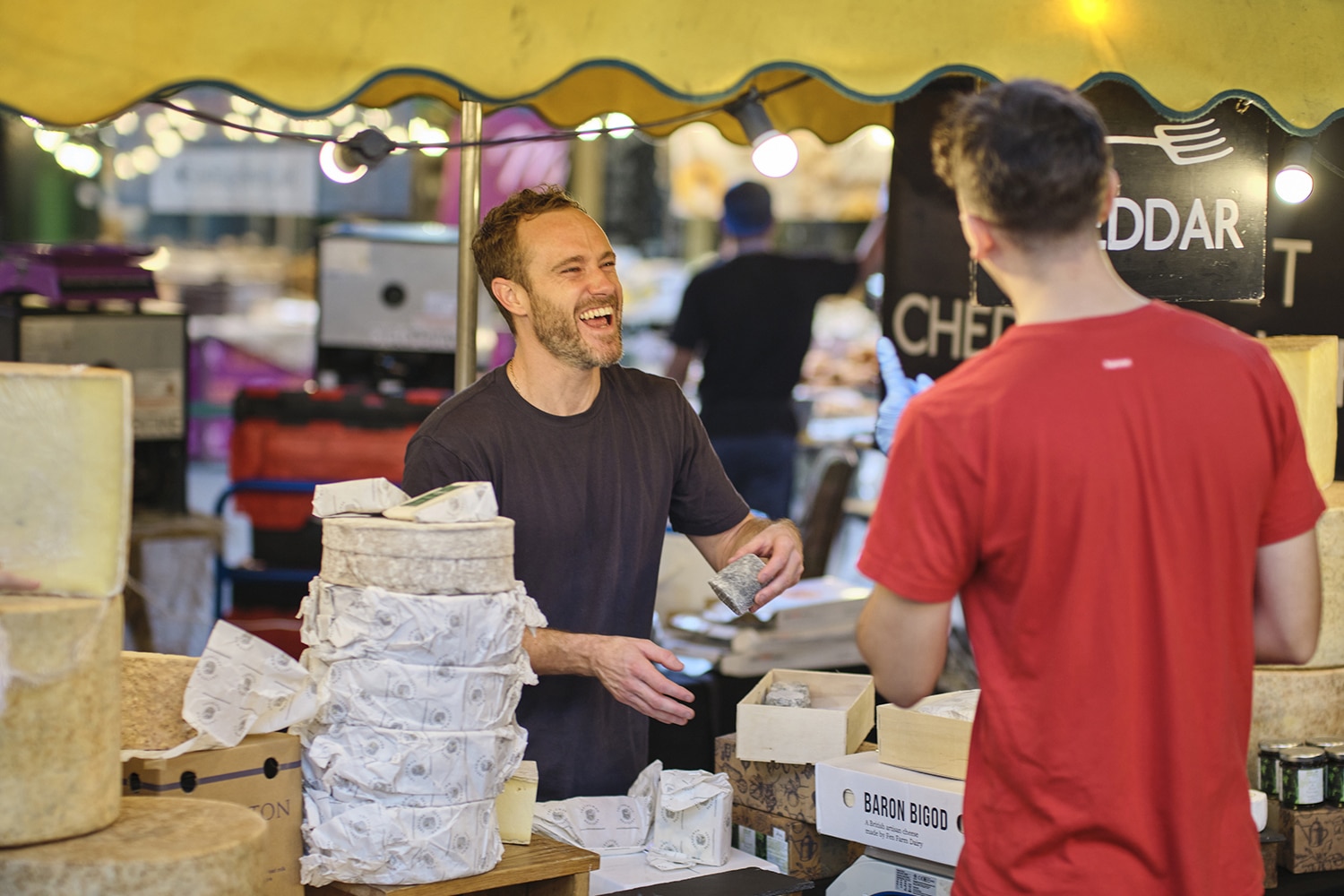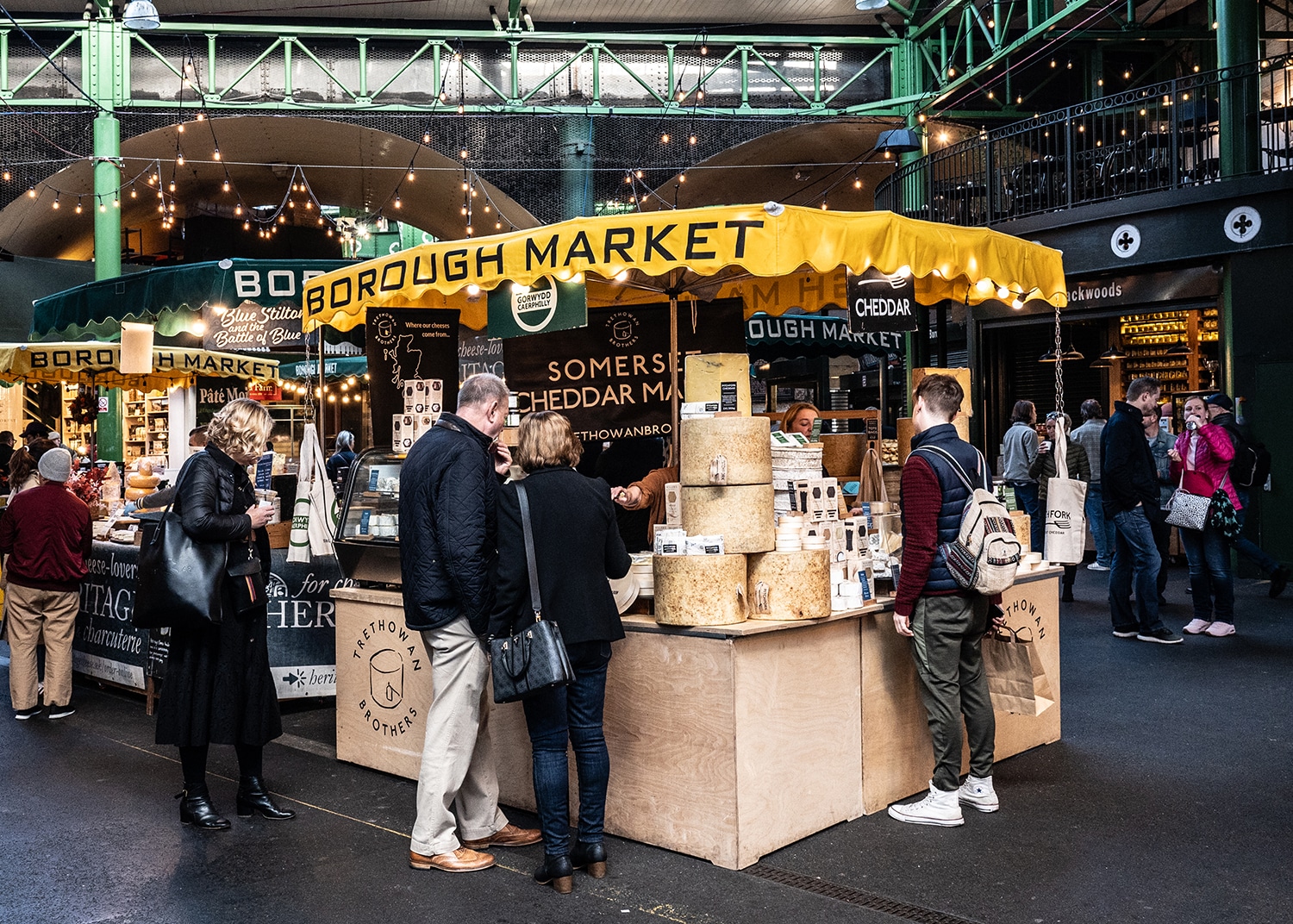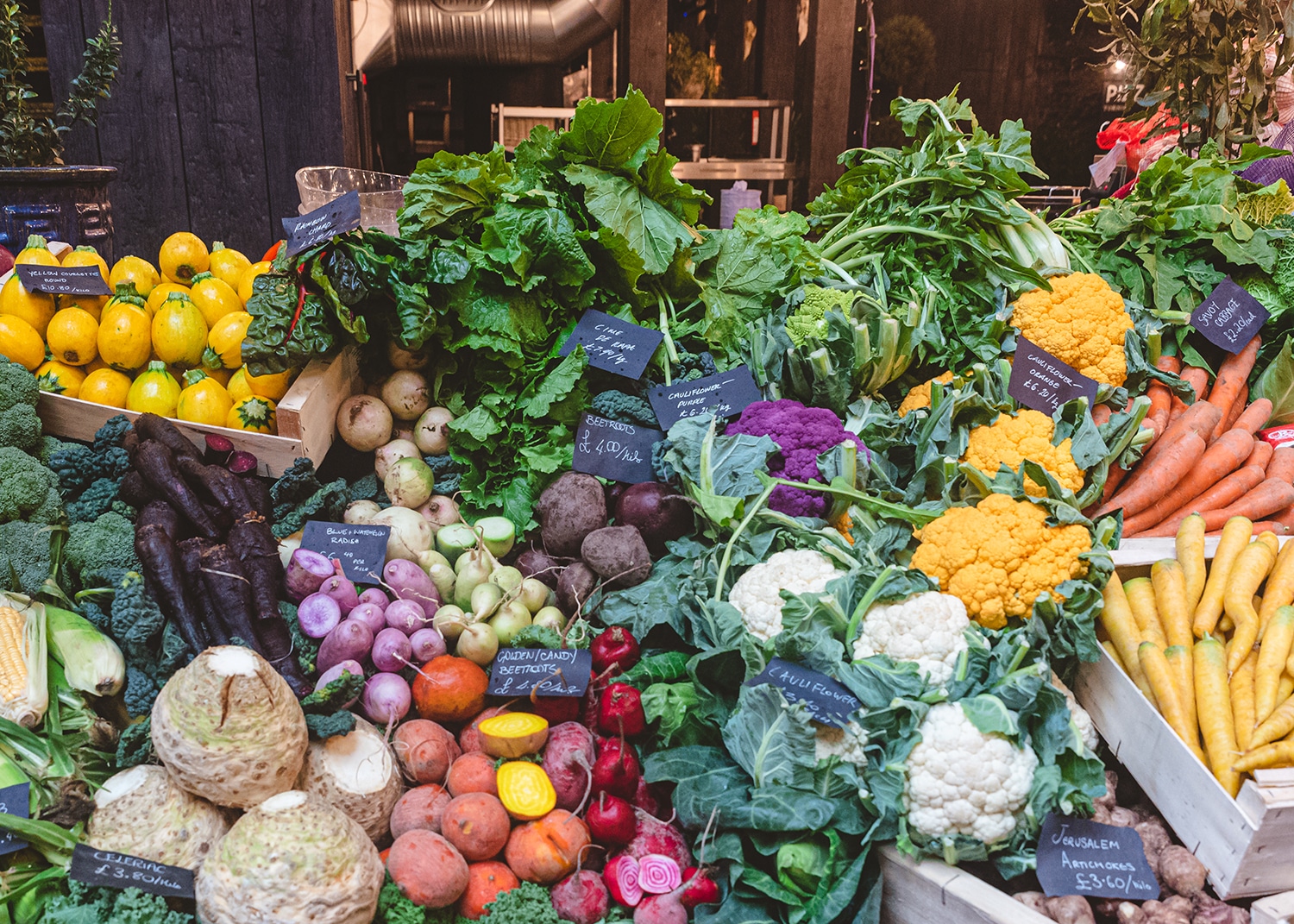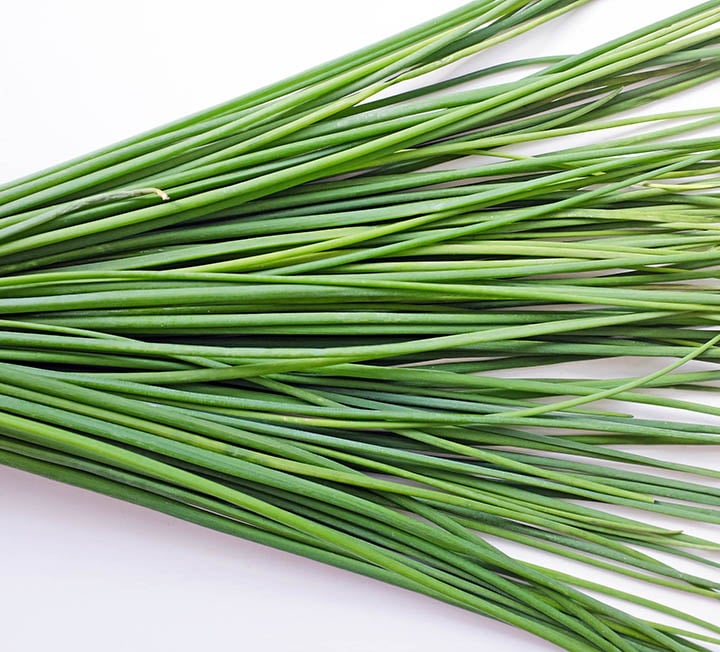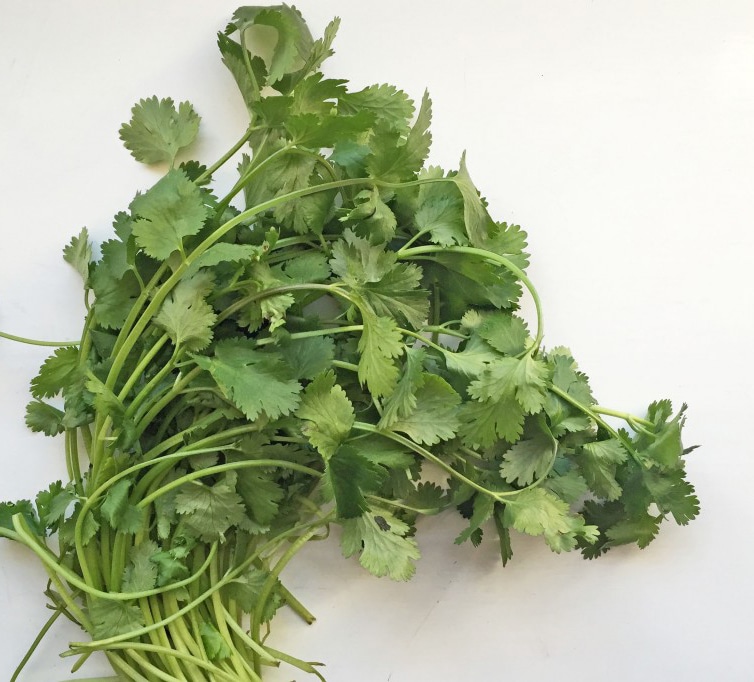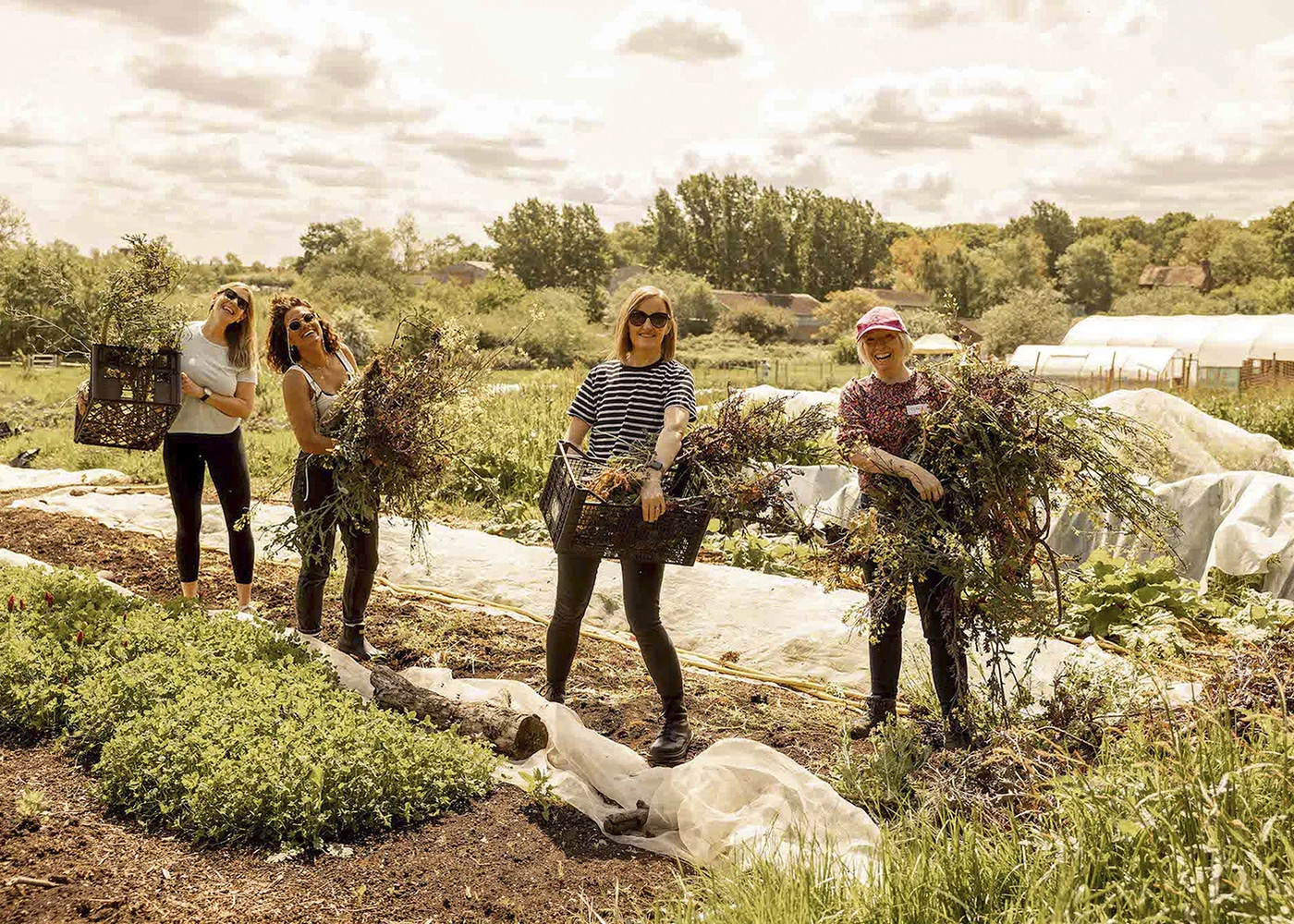Loaf story
How the fates lined up to lead Marzena and Nigel of Ma Ma Boutique Bakery to their gluten-free bakery stall at Borough Market
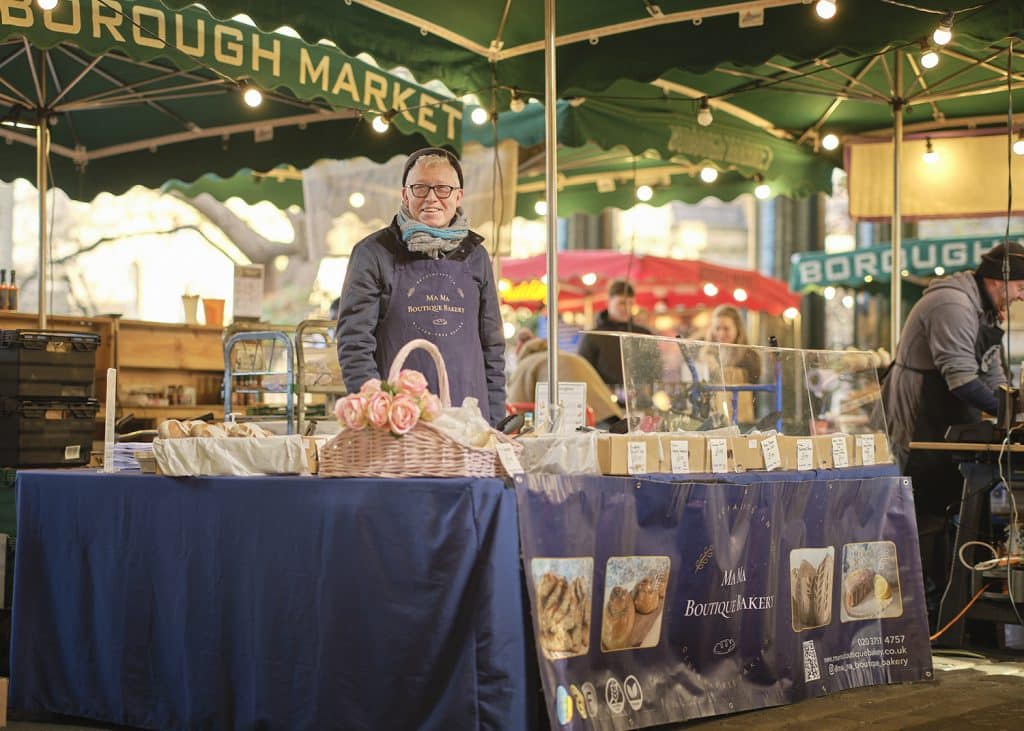

“I NEED TO KEEP THE FOOD HEALTHY; JUST A FEW NATURAL INGREDIENTS, NOT 1,000 INGREDIENTS IN A BOWL”
Words: Mark Riddaway
It turns out, if you wind it all the way back, that the story of Ma Ma Boutique Bakery, the most recent addition to Borough’s trader community, began right here at the market.
“I’m Polish, so all my life my grandpa, my dad and now me have made a hare pâté for Christmas,” explains Marzena Lubaszka, one of the bakery’s co-founders. After Marzena laid down roots in London, this required a very specific shopping trip: “Here, to get a hare you had to travel to Borough Market.” Every December, she would pay a visit to the Furness Fish Markets stand to collect hare and venison. One year, she happened to catch the eye of a fellow visitor to the market.
“Marzena was shopping and I was having a few beers in the courtyard of the Wheatsheaf pub with some German friends,” says Nigel Ryan, her husband and business partner. “I asked for her number, but she wouldn’t give it to me. After a little bit of cheek from me, she agreed to take mine. It all started there.”
Their marriage came first, their bakery came later, and its creation was a response to a less cheerful confluence of fates than their initial crossing of paths. “Nigel had bowel cancer,” says Marzena. “After the surgery, his surgeon suggested a gluten-free diet.” Around the same time, Marzena was advised by her endocrinologist to cut out gluten in the hope of relieving a thyroid problem.

Marzena, a trained chef and dietician who grew up in a family steeped in food (her grandfather was a professional baker, her parents mushroom farmers), wasn’t prepared to let the sudden removal of gluten from the household undermine the quality of her domestic output. “I’ve always been baking, always making everything from scratch, always having people over for dinner parties,” she says. “That was me, always with food.” To her, the next step was obvious: teach herself to be the best-possible gluten-free baker.
The problem is, becoming a really good gluten-free baker is much easier said than done. Gluten is a truly magical substance: an elastic, net-like structure formed when the proteins in wheat flour come into contact with water. Many of the qualities we value most highly in breads, cakes and pastries – lightness, airiness, chewiness – develop from gluten’s unique binding properties and its ability to sequester air within its robust but stretchy strands. Take that wizardry away and you risk being left with something more brick than bread.
A cursory examination of supermarket products made clear to Marzena that the solution favoured by large-scale food manufacturers is to throw industrial chemistry at the problem: starches, humectants, stabilisers, gums. “I looked at the ingredients and there were things I couldn’t understand,” she says. “I couldn’t even pronounce some of the names. So much different stuff. But I started gluten-free baking because of health reasons, so I need to keep the food healthy; just a few ingredients, whatever is natural, not 1,000 ingredients in a bowl.”
Marzena set out on a mission to match the purity of a regular sourdough loaf: flour, water, salt and the magical microbes of a sourdough starter. “I’m very passionate about my breads; every day I work on their crumb, to be less dense. It’s very difficult to achieve, but I have a very strong work ethic.” It is, she suggests, a craft, not a science. “Dough is alive. I’ve been doing this for a long time, so just by touching the dough I know exactly whether it is good or not. Everything needs a personal touch.” She applies the same care to pastries, cakes and desserts: simple, unadulterated, packed with flavour, but absent the gluten.
What began as a personal quest became a business after Nigel’s health challenges required him to step back from his City job. “We had some savings, and we came up with this idea – to help people like us, to help coeliac people, to help the community, because the alternatives from the supermarkets are not good,” says Marzena. As she and Nigel had discovered, living without gluten creates deeper problems than a lack of lunch options. Bread is such a pillar of our culture that ‘breaking bread’ has become a synonym for hospitality and companionship. “If you’re coeliac, you can’t break bread with people,” says Nigel. But you can if the gluten-free bread is so good that everyone at the table is happy to share it. “If you’ve got the best ingredients and make it properly, good food is good food, whether it’s got gluten in it or not.”

Foremost among their ingredients is organic buckwheat flour from Shipton Mill in Gloucestershire. Made from the grain-like seeds of a flowering plant, this earthy, aromatic flour is common in Slavic cuisines, so Marzena already had a feel for its properties. “I am Polish, and we love buckwheat!” she says. Her arsenal also includes high-quality millet, sorghum, teff and psyllium husk, a natural product made from the fibrous skins of the seeds of the Plantago ovata plant. “It works like gluten – it binds the flour,” says Marzena. “There are different grades of psyllium husk, different purities, and ours is 99 percent pure. We’ve got a beautiful supplier who gets it from an organic farm in India.”
In 2022, the couple took a lease on a small bakery and cafe in Chiswick, with Marzena manning the ovens and Nigel looking after the shop. The impact was immediate. “When we first opened, a lady came in and started getting quite emotional,” says Nigel. “I asked if she was okay. She said: ‘I’ve been coeliac for 58 years and I’ve never had a choice like this before.’ Apparently, she used to have to order gluten-free bread from the NHS, and it came in the post. She said it was like a rock – virtually inedible. Seeing all this, she was a bit overcome, but in a good way!”
They’re now in a position to share that feeling with a far wider constituency. Growing demand for their products led to them taking a stall at Borough Market this summer, which immediately doubled the workload of their tiny team. “It’s a challenge, especially when you’re driving into work at 2 o’clock in the morning,” says Nigel. But other than picking up a parking ticket on their very first day at Borough, their experience here has been nothing but positive. “We’ve loved it. There’s been a lot of excitement from people: ‘Everything’s gluten-free?’ they ask. Yes, everything’s gluten-free, baked in our bakery. ‘Wow! And when was it baked?’ Today. ‘Today?!’ They can’t believe it.”
A few years ago, before Nigel’s cancer and Marzena’s malfunctioning thyroid, the idea that they’d end up selling gluten-free bakes from a market stall would have seemed completely preposterous. But some things are clearly just meant to be. “We met at Borough Market,” says Nigel. “Having a stall brings us full circle. Fate, I think.”
Happy valley
How Jumi Cheese has transformed Borough Market into a corner of Switzerland’s Emmental Valley, where dairy rules supreme
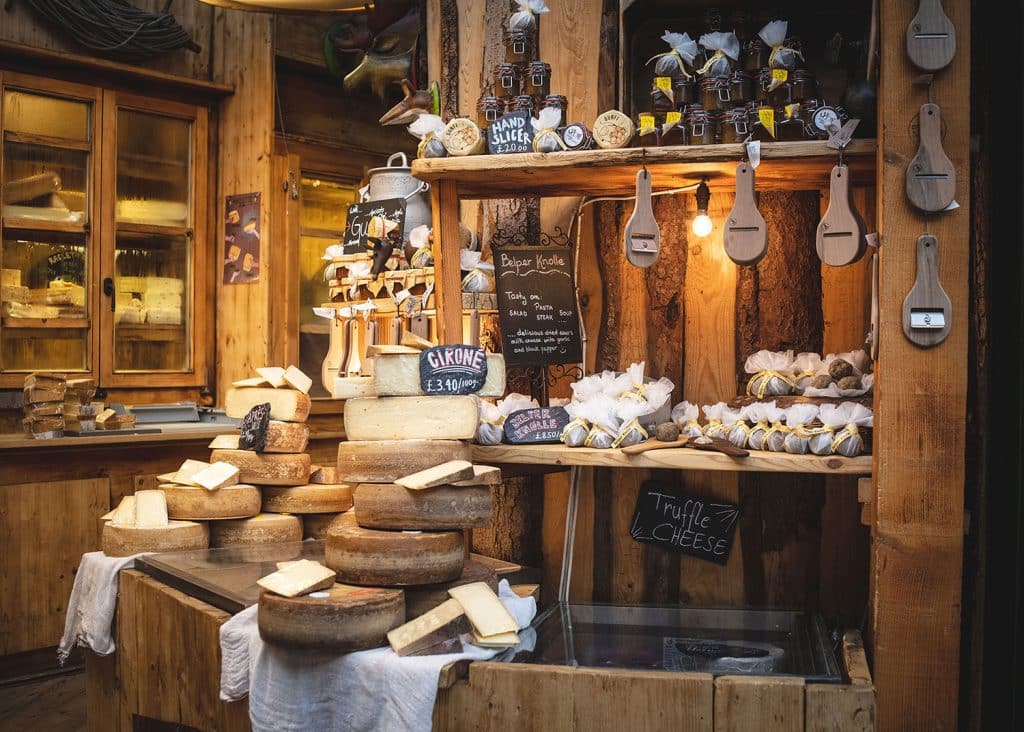

“JUMI’S CHEESEMAKERS ARE AS SMALL AS IT GETS, ALL USING RAW MILK AND FOREGOING INDUSTRIAL STARTER CULTURES”
Words: Tomé Morrissy-Swan
Among the butchers, bakers and street food vendors of Borough Market, eagle-eyed visitors will have noticed something curious – just how cheese-oriented the market is. And with more than 20 cheese purveyors there’s something for everyone. Fans of British and Irish might flock to Trethowan Brothers or Neal’s Yard Dairy. Those of a French persuasion will often make a b-line for Mons Cheesemongers.
For Swiss, one stall stands out. From fondue kits and gigantic wheels of Emmental to all sorts of innovative, flavoured soft cheeses, Jumi Cheese has become the go-to place for lovers of all things alpine.
Jumi (pronounced ‘You-Me’) was founded by two Swiss cheesemaker friends, Jürg Wyss and Mike Glauser, in the Emmental Valley in 2006, although their cheesemaking DNA has been passed down at least five generations. Until the 21st century, their wares were only sold at local markets, but Jürg and Mike decided they wanted to do more to showcase the fruits of their fertile, picturesque valley, where dairy rules supreme.
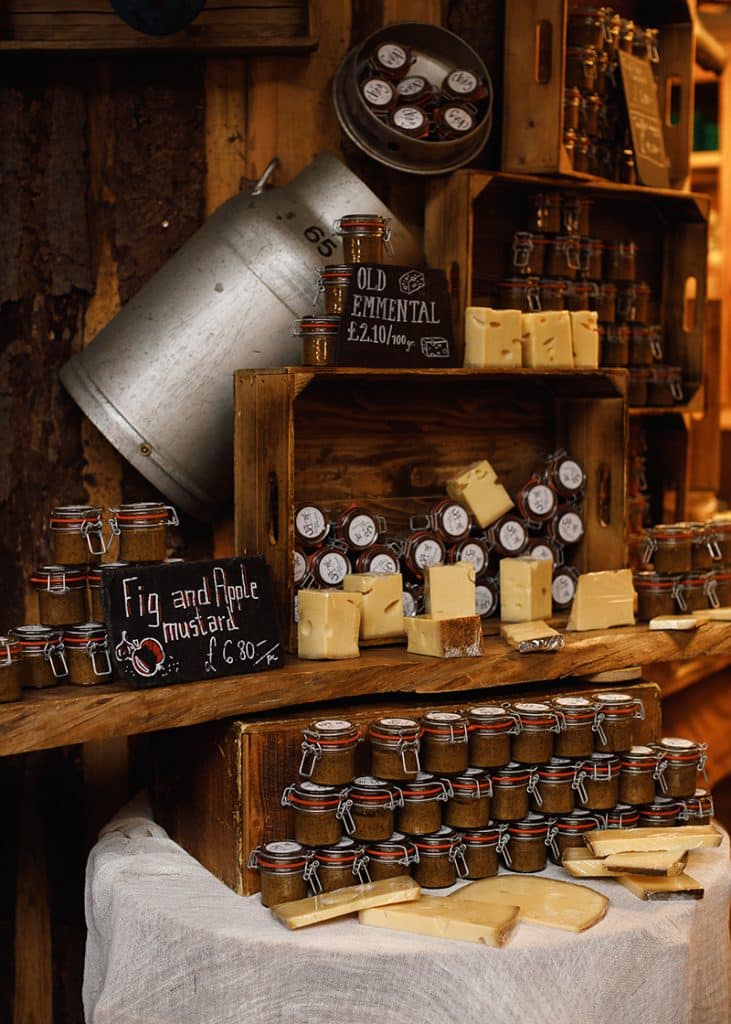
Marcello Basini, who heads up Jumi’s London operation, explains how despite scaling up, the business remains very much a family affair: “If you go to the main dairy, it’s the father of Mike who’s still there in command. Mike’s brother is in the dairy as well. Everyone is involved: relatives, wives, cousins.”
There is a somewhat paradoxical nature to Swiss cheese. It is thought of as among the best – if not the best – on earth. Gruyere is regularly named the best cheese in the world, and the jangle of cow bells in an alpine meadow is as evocative a sound as they come. Yet ‘Swiss’ is also an implausibly wide category. Emmental is apparently the world’s most imitated cheese, and a whole section of American mass-produced knockoffs comes labelled as ‘Swiss’ (essentially, anything with holes). According to Marcello, however, the Emmental Valley is losing cheesemakers every year. Jumi is part of the fight to keep them going.
Yet Jumi is by no means a comprehensive shop. “A lot of people think of us as Swiss but actually, in a way, we’re not,” admits Marcello. “We’re not Swiss as a whole. Switzerland is a small country, but when you talk about cheese, there are just so many. We like to stick with what we do best in our region.” The only exception is one gruyere, kept for those who insist on buying the country’s most famous cheese. Of course, Marcello adds, it is made by a second cousin, so “it’s still kind of within the family”.
From humble beginnings on Saturday mornings at a Bern farmers’ market, which they still attend, Jumi moved to Borough Market in 2011, first with a stall then, when Three Crown Square reopened in 2013, a permanent stand. A bestseller, and Jumi’s signature cheese, is Schlossberger, an alpine hard cheese. How does it differ from the more famous gruyere? “The style is similar, but the taste is different,” says Marcello: a touch sweeter, smoother and earthier.
But Jumi does far more than the mighty alpine wheels for which Switzerland is famed (a single wheel of Emmental can weigh 100kg). On a less traditional note, there’s truffle brie, chilli brie and one with black garlic. Surprisingly, probably the bestseller overall is Belper Knolle, a small ball that looks remarkably similar to a truffle. It’s a hard cow’s cheese with added garlic flakes, black pepper and Himalayan salt, designed to be shaved (like a truffle) over pasta, salad, scrambled eggs, risotto, soup and more. It’s a real flavour bomb.
Blue Brain, which looks exactly as you’d expect, like a cartoon cerebrum, is mild and creamy – or at least the young version is. The six-month aged option, which grows faintly terrifying yet perfectly edible moulds, is wincingly tangy and sharp, but popular among thrill-seeking blue cheese lovers. How much can he manage in one sitting, I ask Marcello. A grape-sized morsel, he warns, is about enough.
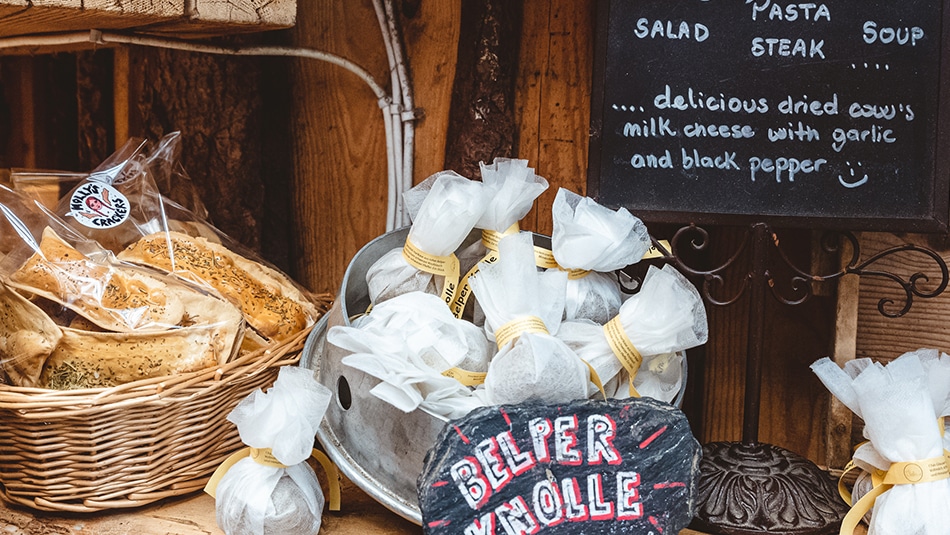
Jumi Cheese has found its niche and is sticking to it. Recently, the British government placed a temporary ban on the import of certain unpasteurised soft French and Italian cheeses in a somewhat drastic response to an infection outbreak among continental cattle. Several Borough cheesemongers have been affected by the ban, but Jumi has no desire to take advantage. Several customers have asked Marcello if he will source the likes of vacherin, a cheese which can be made in regions of both France and Switzerland. “There’s no interest,” says Marcello. “We like to be genuine with what we do. This would be making money from reselling someone else’s cheese from a different place. That’s not our ethos, that’s not what we do.”
“The amazing thing with Switzerland is you still have so many small farms, with 20 to 30 cows in a farm,” he adds. “There aren’t many other places where you see this. There’s also help from the Swiss government.” And Jumi’s cheesemakers are as small as it gets, all using raw milk and foregoing the industrial starter cultures that can lead to standardised flavours, instead passing their unique signature down through the generations.
“Having a niche has helped us. We’re the place for raclette in winter. There are other people selling raclette but people recognise that the quality is with us,” explains Marcello, who points out that the likes of raclette and gruyere are made by thousands of producers, meaning that the quality can vary wildly. He likens Jumi’s output to single vineyard grand crus: “We’re single meadow, single field.”
Territorial army
Bronwen Percival of Neal’s Yard Dairy on why British territorial cheeses warrant a prominent place on your Christmas cheeseboard
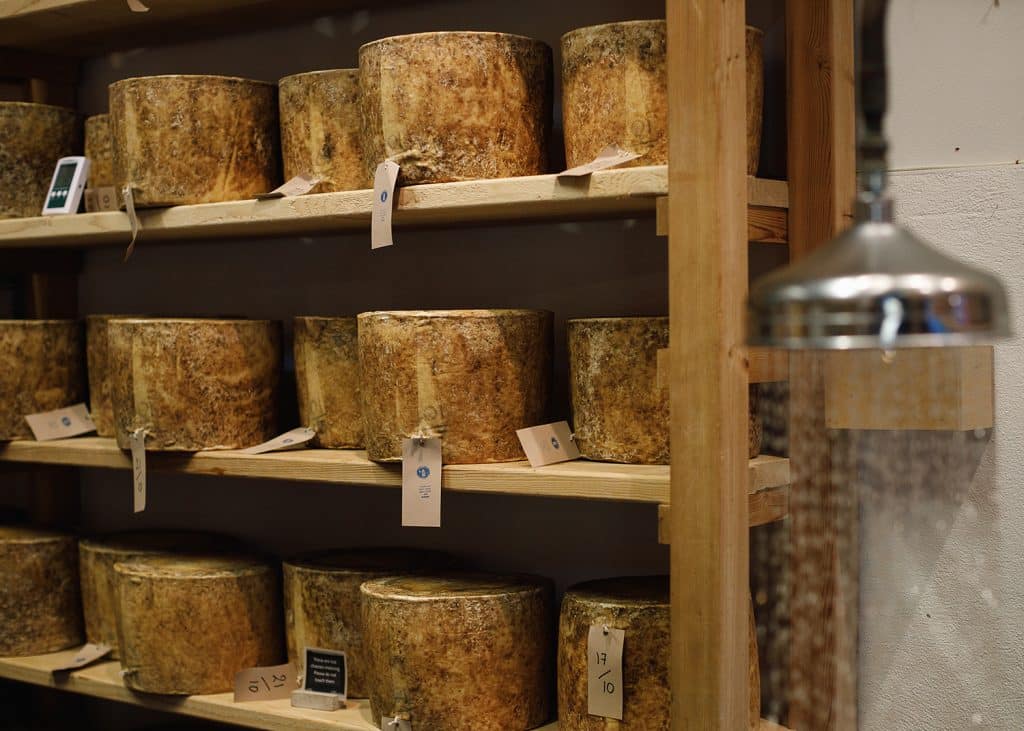

“THESE CHEESE ARE A UNIQUE SET OF ANSWERS TO THE CHALLENGES POSED BY OUR CLIMATE AND SOCIAL STRUCTURES”
Interview: Mark Riddaway
Eat them or lose them. That’s the stark message of a campaign by Neal’s Yard Dairy to raise awareness of ‘British territorials’, a loose family of cow’s milk cheeses that tend to take their name from a specific county or locality: Cheshire, Lancashire, Wensleydale, Caerphilly and many more.
These cheeses share more than just a naming convention. “You might look at stilton and Lancashire and think they have absolutely nothing to do with one another, but if you really dial into how they’re made, you’ll see there are so many similarities,” says Bronwen Percival, technical director of Neal’s Yard Dairy. Their form, she explains, is fundamentally British, “a unique set of answers to the challenges posed by our climate and social structures”.
They share history. They share form. They also share a worrying vulnerability. Many of these territorial cheeses, which have been a cornerstone of our culinary culture for centuries on end, are either extinct or on the verge of extinction. A quick glance into the fridges of a supermarket might lead you to infer that some are thriving, but they live on in name only – an industrially produced Cheshire cheese, for example, has almost nothing in common with the traditional farmhouse version, of which only a single producer has survived.
With the dairy industry’s most important month of the year upon us, Bronwen sat down to explain what makes these cheeses unique and why they warrant a prominent place on our Christmas cheeseboards.
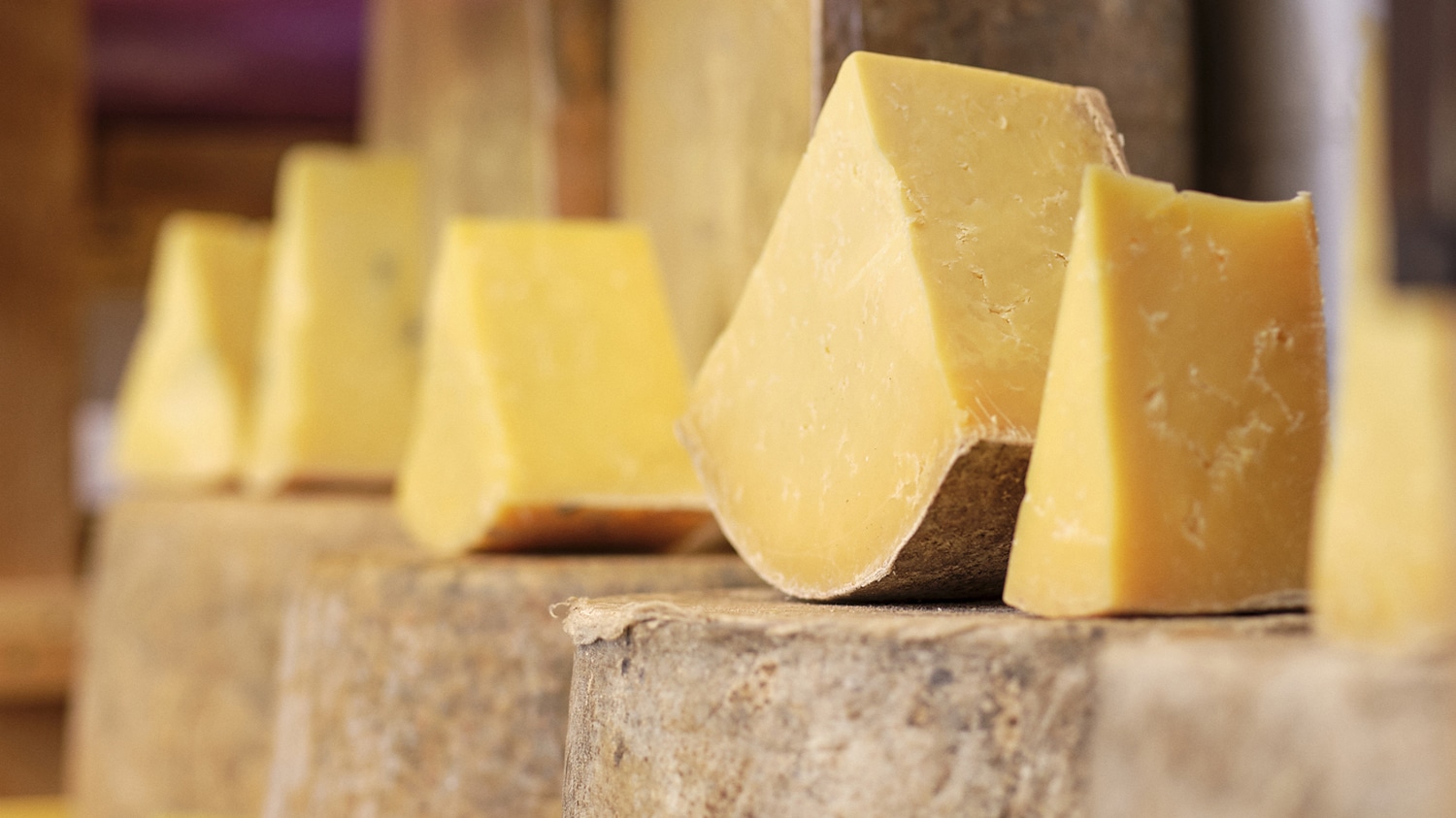
What is it these cheeses have in common, and what makes them uniquely British?
One of the key things about Britain is that it’s cold and grey and it rains a lot. Historically, that made it really difficult for farmers to make excellent hay. There are these spores called Clostridium tyrobutyricum that thrive in damp hay. When that gets into cheese, particularly the kind of low acid, cooked, pressed cheeses we associate with alpine production, it starts to develop this putrid gas. It’s basically the taste of vomit. In some old books, they call these “heaving cheeses”. Over the course of hundreds of years, British cheesemakers realised that the slower the make, the more acidity developed, the lower the chances that their cheeses would go bad as they matured. All of these cheeses are made with a long, slow acidification, a method which is almost completely unique to Britain.
So, if they’re all made in a broadly similar way, what is it that creates such clear regional differences?
A lot of it’s to do with how the drainage of the curd and the acidity development align with one another, and the timings involved. But those differences weren’t always so clearly defined. When you look back far enough, the way cheese was made in Cheshire, from farm to farm, would have seen lots of very different permutations. The sense that we know what Cheshire looks like and what Lancashire looks like is the culmination of a Victorian impulse to standardise things. There’s also a bottlenecking effect that happens when you go from having thousands of small farmhouse cheesemakers to just a handful. Appleby’s is the only raw-milk farmhouse Cheshire left, so that is now the absolute definition of traditional Cheshire, but the sheer variety of Cheshire cheese 150 years ago would have blown our minds.
Wasn’t Cheshire once Britain’s most widely eaten cheese?
It was – even more so than cheddar. Cheshire was the cheese that first escaped its county, shipped around on canal boats. Everyone ate Cheshire, and cheddar barely registered by comparison. Now the tables have turned. Cheshire is like the panda, an endangered species.

So why is it that these cheeses at risk?
The problem is that many of the best British cheesemakers want to make European-style cheeses. We’ve got Baron Bigod, we’ve got St Jude, we’ve got all these beautiful, wrinkly-rind cheeses, but the old territorials simply don’t have the same cachet anymore. When a cheesemaker comes to us and asks, “What should I be making?” I want to say, “You should be making a Dales-style cheese, because you’re in the Yorkshire Dales; you should be making something that’s rooted in the place where your farm is located.” But it’s very hard to say that when you look over our sales sheets year on year and see that territorials are holding flat at best while all these other continental styles have tremendous energy behind them.
How much does that loss of cachet come from the fact that I can walk into any supermarket and pick up something cheap and plasticky that bears the name Lancashire or Red Leicester?
One hundred per cent. About five years ago, when the Hattan family started making Stonebeck Wensleydale on their remote farm in the Yorkshire Dales, they initially didn’t want to call it Wensleydale, because they felt the name had been so devalued by the factory version. Industrialisation has completely changed the face of these cheeses. Instead of maintaining the traditions of cloth binding and a slow make, the emphasis is on speed and consistency – adding more starter cultures, flattening out the flavour, removing the rinds. Who wants to deal with a rind when you could have a completely perfect vac-packed cube that won’t lose weight and can be matured in a fridge for six months? As a result, when people go into a shop and buy a packet of something called Wensleydale or Lancashire the experience they’re having is a far cry from what those cheeses traditionally tasted like.
It’s not all doom and gloom, though, is it? Red Leicester in its traditional form was essentially extinct, but then two young cheesemakers, David and Jo Clarke, saw an opportunity to rescue it from the dustbin of history by creating Sparkenhoe, which is amazing.
Yes, that provides some hope. I think their success has been a testament to the fact that the world is interested in these kinds of cheeses, as long as you make them with integrity and communicate clearly. Our challenge is to create the demand so that more cheesemakers are inspired to do something similar – our dream is to have 10 Red Leicesters to choose from. We also need to help keep the existing cheeses going. The moments of extreme peril are those intergenerational transfers, when older cheesemakers retire. The business needs to be secure enough to attract the kids that could otherwise do something different with their lives and enjoy weekends and holidays where they’re not milking cows and making cheese.
Is there something about the winter months – and the Christmas period in particular – that makes these territorials particularly appealing at this time of year?
Yes! These are cosy, warm, snacking-by-the-fire cheeses. There’s something very wholesome and comforting about them that fits perfectly. They also make sense in terms of the entire farming system. Lots of people want their Christmas cheeseboard to have one of everything, but having a soft, young goat’s cheese is as unseasonal as it gets. The animals’ natural cycles are about producing milk in the summertime, and it’s hard work to get them to milk in winter. A lot of these territorial cheeses are made in the summer when milk is plentiful, then they’re perfectly ready to eat at Christmas.
Also, at a time of year when fridge space is at a premium, is there something to be said for the fact that these cheeses can live quite happily without refrigeration?
They’re so much better when you don’t put them in the fridge! If they’re served cold it kills the entire experience – all that subtlety and complexity disappears. If you have to choose one item to leave out that’s going to be perfectly safe at a cool room temperature and will actually improve as a result, this is it.
Food for thought: reflecting London’s diversity
Author and consultant Mallika Basu answers our question: is London’s vibrant food culture fully reflective of the city’s diversity?


“ENSURING THE FOOD SCENE REFLECTS LONDON’S MAKEUP DEPENDS ON US DISMANTLING BARRIERS TO ENTRY AND SUCCESS”
Portrait: Zoe Warde-Aldam
Borough Market, which is run by a charitable trust, exists “for community, the love of food and a better tomorrow”. This statement informs everything from our Food Policy to our work with local schools; it also sparks lots of questions about what we do and why we do it. This autumn, we’re throwing some of those same questions out to experts beyond the Borough Market community.
This week’s answer comes from Mallika Basu, a speaker, consultant and author whose new book, In Good Taste: What Shapes What We Eat and Drink – And Why It Matters, is available for pre-order.
Is London’s vibrant food culture fully reflective of the city’s diversity?
London is proudly – and famously – a bubbling cookpot of cultures. Its nearly nine million residents speak around 300 languages, more than any other city in the world. Almost half of all Londoners identify with non-white ethnic groups, and more than a third were born abroad. Nowhere is that multiculturalism more deliciously evident than in its food.
Walk down any high street and you’ll find food that tells the story of its local community, fighting against the tide of identikit chicken shops and chain retailers. The south Indian and Pakistani family diners of Tooting, the kebab shops of Little Turkey in Haringey, the Caribbean eateries of Brixton – all speak of migration, adaptation, enterprise and resilience.

There is a special joy in watching the upward trajectory of these restaurants’ founders. Mandy Yin started as a market trader before turning Sambal Shiok into a haven of luscious laksa in Islington. Asma Khan took Darjeeling Express from a supper club to a globally reputed all-female central London restaurant. And Joké Bakare of Chishuru went from a six-month residency in Brixton Village, which she landed as a competition prize, to becoming the first Black female chef in the UK to win a Michelin star for her vibrant, west African-inspired cooking.
Everywhere, we’re seeing expansions, upgrades and exciting new offerings. The feted Singburi in Leytonstone, one of London’s most beloved Thai BYOBs, is finally evolving into a full-scale restaurant, building on years of word-of-mouth devotion. Akara, an outpost of Fitzrovia’s Michelin-starred west African restaurant Akoko, has set up close to Borough Market, and there are plans for further ventures. The “Chongqing noodle queens” Charlene Liu and Liu Qian have opened a third Liu Xiaomian in Charing Cross. Even Mayfair appears to be turning into an upscale Brick Lane.
Cumulatively, these stories highlight a food scene diversifying from the ground up. Yet ensuring it truly reflects the city’s makeup still depends on us dismantling the barriers to entry and success.
The socioeconomic obstacles facing diverse entrepreneurs remain high. And if anything, they’re getting harder to overcome. Setting up, marketing and running a restaurant demands serious capital. In an already punishing market, a lack of generational wealth, limited access to investors and a bias toward “tried and tasted” cuisines often make it harder for new players to break through. This curbs the emergence and expansion of fresh ventures, keeping many confined to outer neighbourhoods rather than the prestigious postcodes of central London.
Then comes the dreaded b-word: buzz. It’s the oxygen that all restaurants need to survive, and it doesn’t come easy. Some of that buzz is down to luck, but most is the product of savvy PR, constant content and social media sophistication. For many founders, especially those juggling everything from menu design to staffing on limited budgets, a high level of digital acumen – and the time needed to mine it – can feel out of reach.
Even when the product and storytelling are spot on, the wider landscape is unforgiving. Inflation, the cost-of-living crisis and economic uncertainty are squeezing household budgets. As Harden’s reports, the restaurant market has flatlined for seven years, shrinking from around 18,000 venues in 2017 to just over 11,000 in 2025. Rising costs, staffing shortages and mounting tax pressures have stirred an imperfect stew. For ethnically diverse entrepreneurs already fighting for visibility and capital, it can feel like being asked to cook a family feast without the key ingredients.

This also throws into light what and who we choose to value. When wallets and risk appetites shrink, appetites themselves often turn to the familiar. Restaurant PR Hugh Smithson-Wright notes: “As eating out becomes less affordable, diners are less willing to take a chance on unfamiliar cuisines and culinary styles and look for familiarity they can be confident they’ll like – French brasserie food and Italian particularly.” Investors too gravitate towards comfort and convention. Together, perhaps these factors explain the quiet resurgence of classical French cooking and other Euro-leaning menus across the capital.
That instinct for the familiar runs deeper than taste. Representation in senior roles, ownership and media coverage still skews narrow. Many talented chefs and founders from minority backgrounds struggle to access the same networks, mentorship or capital as their white counterparts. Recognition, meanwhile, often follows contacts and exposure, a cycle that keeps power and visibility concentrated in familiar faces, voices and hands.
Despite the challenges, there are reasons to be hopeful. London’s residents have a taste for the world and an endless curiosity for the new. Its diverse communities have resilience baked in. A new generation of food founders is reimagining what success looks like, turning conventional wisdom on its head and bringing more of themselves to the table. Incubators, accelerators and platforms like KERB and Black Eats LDN are championing tomorrow’s stars, while a growing community of standout success stories continues to inspire progress.
There is more to be done. As veteran restaurateur Iqbal Wahhab notes: “Savvy landlords should deploy talent scouts to Brixton and Brick Lane and help make the West End even more deliciously diverse and their spaces sparkle by finding the Jamaican equivalent of Asma or the Bangladeshi equivalent of Joké.”
Borough Market is a living example of how good food and opportunity can thrive side by side. If London’s food scene shows us anything, it’s that when barriers fall, flavour flourishes and everyone gets to taste the benefits.
Food for thought: the impact of social media
Food stylist and writer Kitty Coles answers our question: is social media transforming our relationship with food for the better?


“A PLATE OF PASTA IS NOT ENOUGH; IT NEEDS TO BE SWIRLING IN SLOW MOTION WITH CHEESE RAINING DOWN FROM ABOVE”
Borough Market, which is run by a charitable trust, exists “for community, the love of food and a better tomorrow”. This statement informs everything from our Food Policy to our work with local schools; it also sparks lots of questions about what we do and why we do it. This autumn, we’re throwing some of those same questions out to experts beyond the Borough Market community.
This week’s answer comes from Kitty Coles, a food stylist, writer and recipe developer whose images and videos, captured on her phone as she cooks, have garnered a significant following on Instagram.
Question: Is social media transforming our relationship with food for the better?
I grew up with both parents running a restaurant in the southwest of England – a converted pub with big open fires and daily-changing menus written on a chalkboard. My mum made all the desserts at home, so most days I’d come back from school to find every surface (and wall, and a bit of floor) covered in spun sugar, which I’d go around picking off as a snack. She taught me to make shortbread when I was about seven or eight, and by 11 I was baking it for the restaurant whenever they needed extra hands.
I had an extraordinarily food-focused childhood but there are almost no photos to show for it. The restaurant closed in 2016 when my parents retired, and barely a trace of it still exists. People came to eat, drink and sit by the fire without ever feeling the need to prove it online. They found out about it through word of mouth or simply by walking in. You had to call to make a booking – names and times written in a big reservation book – because Resy, OpenTable and SevenRooms weren’t a thing yet. There were no hashtags or @s, no Instagram stories or TikTok trends.

Fast forward to 2025 and that world feels like another planet. If I want to go to a restaurant now, even if it’s been personally recommended, I head straight to Google or Instagram to look at tagged images before booking. I want to see what the room looks like, what the food looks like, what everyone else has ordered. Sometimes it’s not about the menu but about the mood – the glow of the lighting, the plateware, the crowd. You can decide if a restaurant is “your thing” without ever stepping through the door.
In some ways, it’s incredible. I recently went to a big party thrown by the Topjaw social media channel. It felt like every cook and chef in London was in one room talking about how the algorithms had helped their businesses in ways they could never previously have imagined. One chef told me that after Topjaw featured their restaurant, there were queues down the road the very next day – and they’ve been there ever since.
There’s no denying that social media has transformed the way food is shared and discovered. I follow restaurants and cooks all over the world – small bakeries in Seoul, taco trucks in Los Angeles, grandmothers cooking in Sicilian kitchens. It’s made food more global, more inclusive, more immediate. A dish can go viral in Tokyo and be recreated in London within hours.
People can now build entire careers from their kitchen counters, often without any formal training, simply by being creative, consistent and clever online. That’s something my parents’ generation couldn’t have imagined – the idea that a phone, a good idea and a bit of persistence could launch a food career.
And even though I hate to admit it, I owe a lot to social media myself. I’ve built a portfolio that shows my style of cooking; it’s how I share my recipes and writing and connect with people who cook them. The biggest compliment I get is when someone says they recognised a dish as mine before even reading the caption – which, in a world of millions of food photos, feels like a small miracle.
But it has also changed the industry in ways that feel more complicated. The point, increasingly, is to show food rather than simply make it. A plate of pasta is no longer enough; it needs to be swirling in slow motion with cheese raining down in high definition. It’s surreal watching people cook for the camera, narrating each step as if rushing to get to the final “wow” moment.
A content creator I know once told me she doesn’t make something for her page unless it has that viral moment – and that most of her ideas come from TikTok or Instagram. She’ll see a recipe she likes, note how many likes it got, then recreate it at home in her own style. The inspiration starts from an image, not from mood or taste or seasonality. And while that might make for good engagement, it also feels like a loss. The food world used to move more slowly, more organically; ideas came from eating, travelling, talking, from what was ripe and ready that week. Now, trends decide what we cook before the produce does.

The irony, of course, is that some of the best cooking doesn’t translate well to video – too brown, too slow, too subtle. Delicious braised lentils in a mustard dressing won’t go viral, even though that’s one of my favourite things to eat.
Recipes used to have a kind of permanence – printed in magazines and newspapers, tucked into cookbooks, passed from hand to hand. Now they live in the feed for a day, maybe two, and then they’re gone. Maybe saved to “try one day”, but soon forgotten, buried among thousands of others.
As someone who’s worked in food for years, I’ve learned you have to set your own rhythm. The online world never stops, and if you’re not careful, you start cooking for it rather than from instinct. There’s a pressure to be constantly visible, to post something new every few days, to stay part of the conversation. But I do wonder what will happen to all the food content creators in 10 years’ time. Will they still be posting three recipes a week? Will they have evolved into something else? Or will they, like chefs before them, be forced to find another way of working?
Maybe that’s the real question: what happens when the noise quietens down – when the likes slow and the spotlight moves on? The best cooks will, I think, still be doing what they’ve always done: creating food for the joy of it, not the algorithm.
Food for thought: the weight of history
Writer and historian Mark Riddaway answers our question: is a 1,000-year heritage a blessing or a curse?


“BE HONEST: IF YOU WERE TASKED WITH DESIGNING A WORLD-CLASS FOOD MARKET, IT WOULDN’T LOOK A LOT LIKE BOROUGH”
Borough Market, which is run by a charitable trust, exists “for community, the love of food and a better tomorrow”. This statement informs everything from our Food Policy to our work with local schools; it also sparks lots of questions about what we do and why we do it. This autumn, we’re throwing some of those same questions out to experts beyond the Borough Market community.
This week’s answer comes from Mark Riddaway, a food writer and historian and the author of our book Borough Market: Edible Histories.
Question: Is a 1,000-year heritage a blessing or a curse?
The greatest gift bestowed by history onto Borough Market came from a few quick strokes of a quill. Since the early Middle Ages, a regular food market had been held on what is now Borough High Street. In 1756, in response to crippling traffic congestion on this busy road up to London Bridge, it was announced in parliament that this age-old trading centre would be permanently closed. The local community, facing the loss of a vital asset, lobbied for the right to buy a plot of land just off the main street and move the market there. Their voices were heard. A new law was passed declaring that this relocated market would remain for the “use and benefit” of the public “for ever”. Not on some fixed lease. Not with any break clause. Forever.

Now there’s a bit of luck. As a result of a centuries-old Act of Parliament, Borough Market is still owned by the community, in the form of a charitable trust. Today, that small patch of land, purchased through what amounted to a local crowdfunding campaign, would go for an absolute fortune. But unlike the many historic city markets whose halls have been turned into flats, offices or retail parks by private landlords or underfunded councils, Borough can’t ever be sold, closed or relocated. Under the terms of the Act, it can’t be anything other than a market – and that will remain the case until either a change in the law or the heat death of the universe.
This unique aspect of Borough Market’s 1,000-year history is a genuine blessing, not just for traders and shoppers but for anyone saddened by the slow hollowing out of our once-characterful urban centres. In other respects, however, its heritage is… if not a curse, certainly a significant challenge.
Let’s be honest: if you were to sit down today with the task of designing a world-class food market, it wouldn’t look a lot like Borough. You’d maybe start with a couple of clear, easily controlled entry and exit points. You’d then sketch out some nice wide passageways, arranged to optimise flow and avoid any bottlenecks. You’d create plenty of space for delivery trucks and refrigerated storage. You’d make the whole place as accessible as possible. You certainly wouldn’t carve a noisy railway viaduct right through the centre and invite the city’s bird population to make itself at home.
Borough Market is, of course, the inverse of all that – a result of centuries of hotchpotch expansion and the fateful decision by the South Eastern Railway company to extend its central London lines in 1862. Consequently, the teams at the market responsible for cleaning, maintenance and security need to be at the very top of their game. So too do the traders, who maintain exemplary standards of food hygiene within a highly complex open-air setting.
In the Venn diagram of blessings and curses, one major consequence of the market’s age sits right in the middle – the crowds. As a direct result of its rich history, Borough looks amazing. It’s not some bland, boxy, echoey structure. Instead, the jumble of old buildings, the collision of architectural styles, the narrow passages, even that damned viaduct, all create an overwhelming sense of character and heritage. Add in the stunning displays of produce that traders take such pride in creating and you have a place where the aesthetics are, along with the quality of the food, undoubtably a major part of the draw.

The result over the past few years, fuelled by the growth of social media-driven food tourism, has been a rapid rise in footfall. Since the 1990s, Borough has evolved from a half-empty wholesale market to a hidden foodie gem, to a regular fixture of tourist itineraries. Visitors now flock here in their millions to take pictures and soak up the atmosphere. There are clearly some benefits to this burgeoning popularity, but they’re not evenly accrued across the trader population. For some of the stalls – particularly fresh produce traders who cater to home cooks – a high volume of people coming to enjoy the feel of the place impedes business rather than bolstering it.
The paradox of popularity is one of the many challenges that Borough Market’s charitable trust will wrestle with in the coming years. But that’s nothing new. Every hurdle faced by Borough in the past 1,000 years, from the closure of the ancient market to the arrival of the railway, to the slow death of the wholesale market in the late 20th century, has somehow been cleared. Only two things have remained constant, both now enshrined in the trust’s official charitable purpose: this is a food market, and it exists in Southwark for the benefit of the community. Exactly what shape that takes has shifted as our city and food system have evolved – and will doubtless shift again.
In this evolution, history has another gift to offer. For all its sense of heritage, Borough Market is not an institution that has ever sought to preserve itself in aspic. Buildings and spaces have come and gone as the market’s size and function have changed. The oldest structures listed by English Heritage are a few unremarkable-looking bollards in the Green Market, dating from 1813. Even a building that appears to be the historic centrepiece of the market is in fact a monument to its evolutionary power. The beautiful Floral Hall portico, originally part of the Covent Garden Piazza, was salvaged during the 1990s redevelopment of the Royal Opera House and installed here in 2003 as the retail market was starting to take off in a big way.
That recently appropriated 19th century façade is a symbol of how Borough Market embraces its history without ever being hemmed in by it. To meet the obligations of that 1756 Act, that’s something this place will have to keep on doing. Forever.
Borough Market at war
How the Borough Market managed to keep feeding London through two world wars despite chronic understaffing and the threat of bombing raids


“THE REMAINING PORTERS WERE IN THEIR FIFTIES AND SIXTIES. THINK DAD’S ARMY, BUT WITH BUSHELS OF POTATOES”
Words: Mark Riddaway
World War I
Thomas Haynes, the superintendent and clerk of Borough Market, was used to handling problems. During his stewardship, the Market was one of Britian’s largest fruit and veg wholesale operations, and the logistics involved in keeping everything flowing smoothly were never short of intimidating. The superintendent’s life was a whirl of litigation, insurance claims, political lobbying and clashes with traders: disputes over the accuracy of the weighbridge, complaints about litter or inappropriate behaviour, arguments about the tardy payment of rent. Then, in July 1914, Europe went to war, and Mr Haynes’s problems got a whole lot more serious.
Hard though it is to imagine now, knowing what we know of the pitiless slaughter that ensued, but the outbreak of the First World War led to a rush of young men eager to enlist. Pumped up with patriotism and convinced they’d be home by Christmas, they queued for hours at recruitment offices, desperate to serve.
These patriots included almost all of Haynes’s staff. Before the start of the war, Borough Market employed 20 porters, their numbers bolstered by regular casual workers. The site was maintained by two full-time handymen and policed by a team of beadles. Most of these were fit, strong and youthful – the kind of men the armed forces were crying out for. One by one, they went to their boss and announced their intention to do their duty for King and country. Haynes did nothing to stand in their way.
The Market began to buckle under the strain. By the end of 1915, 12 of the 20 porters had shipped off to the front, while another two had left to work in munitions factories. Both handymen had also joined up. Even Haynes’s young office clerk, HF Jackson, had exchanged his ledgers for a rifle. The remaining porters were supplemented by a couple of new recruits, but of eight men now doing the job of 20, three were in their mid-fifties and three in their sixties: gnarly and experienced but starting to struggle with the intense physical demands of the job. Think Dad’s Army, but with bushels of potatoes.
In November 1915, Haynes wrote to the authorities desperate that they refuse to accept into the forces any more of the Market’s military-age staff: the accountant, S Bentley; the inspector of the beadles, W Carpenter; and the two fit, young porters that remained, W Dale and W Bach. “To carry on our work has been a most difficult task for some months past, but my trustees have raised no objections to members of their staff enlisting,” he explained. “They now feel, however, that if the Market is to continue its existence as a food distributing centre, the irreducible minimum has been reached.”
Shortly afterwards, with legislation in the pipeline to introduce mass conscription, Haynes attempted to have his two young porters listed as being in ‘reserved occupations’ vital for the war effort. It was an on-going struggle – in November 1916 he was again forced to devote his time to resisting the War Office’s attempts to ship Dale and Bach to Flanders.
It wasn’t just market porters who left Borough in their droves. Haynes was constantly writing character references for employees of the fruit and veg stalls who were entering the forces, or else signing requests to postpone the conscription of staff during harvest periods, particularly during soft fruit season. In January 1917, Haynes wrote to one trader to apologise for being unable to help him find much-needed help on the stall. “Everybody is now down to rock bottom,” he explained.
And yet the Market struggled on, year after year, bringing vital supplies to a much-stretched nation, despite a skeleton staff of slightly decrepit old gentlemen. It even recovered from a German air raid on 5th December 1917, which caused substantial damage to Haynes’s offices and the Market roof. The Market survived, the war eventually ended, some of the traders and porters even made it home. And Thomas Haynes was finally able to get back to worrying about litter and profanities and conflicts over rent, just like the good old days.
World War II
Borough Market survived the Great War, and it just about survived the Second World War too. Between 1939 and 1945, Borough Market continued to function as a vital link in the city’s food supply chain. Unlike meat, butter and sugar, fruit and vegetables were never rationed by the government, but the war effort did result in severe shortages. As a result, the scale of the operation at Borough was significantly curtailed from its pre-war peak, but it never stopped – despite the bombs.
During the Blitz of 1940-1941, Southwark was the most heavily bombed of the inner London boroughs, with 1,651 high-explosive bombs and 20 parachute mines landing on this densely populated area in a period of just eight months. Many of the railway arches around London Bridge were used as air-raid shelters, where the scrabble for sanctuary became a nightly ordeal.

On 29th September 1940, four Borough Market trustees, including three members of the Cheeseman family, were killed while acting as air-raid wardens on Great Guildford Street. A fifth trustee, also a warden, died a few weeks earlier at a shelter on Ewer Street.
The Market itself survived relatively intact. One bomb fell on Green Dragon Court, causing significant damage to the Market’s roof – shrapnel marks from this explosion can still be seen on Southwark cathedral – and another fell on the junction of Southwark Street and Stoney Street.
Working under the constant threat of the Luftwaffe wasn’t easy for anyone. As a wholesale market, a lot of Borough’s most intensive work was done in the very early morning, when greengrocers would arrive on their carts to stock up with fresh produce for the day. The strict blackout restrictions imposed by the government to inhibit the targeting abilities of the bombers meant that the traders’ pre-dawn activities were carried out in eerie, difficult darkness.
Although their intensity dropped off after the horrible peak of the Blitz, German raids carried on intermittently throughout the war, and the workers at Borough Market never felt entirely safe. Then, in 1944 a new threat emerged: rockets, which fell from the sky with no warning at all, often in broad daylight. On 22nd January 1945 a massive V2 missile hit Borough High Street near the junction with Southwark Street. Dozens of people were killed in the Mosers ironmongery workshop that occupied the site, and around 200 other buildings in the vicinity of the market were destroyed or damaged.
Standing at the site of that attack now, watching shoppers meandering in a carefree manner towards the market, set on buying some beautiful ingredients or drinking some excellent coffee, it’s hard to imagine this being a theatre of war – but in the 1940s that’s exactly what Southwark was. Borough Market survived, but many in its community tragically didn’t.
Discover more
Re-user guide
How Borough Market’s traders reduce food waste by making the most of surplus produce and natural byproducts


“IN A MARKET WHERE TOP-QUALITY PRODUCE IS KING, HOW DO YOU ENSURE NONE OF IT GOES TO WASTE?”
Words: Emily Gussin
Step into Borough Market to see what inspiration strikes and you’ll immediately get swept away by the food on show. Abundant displays of fresh fruit and vegetables piled up to the sky, whole wheels of cheese and stacks of freshly baked bread offer a feast for the senses before you’ve even taken a bite. The traders showcase some of the finest food in the country. But in a market where top-quality produce is king, how do you ensure none of it goes to waste?
Many of the market’s produce traders have started to address this question by developing their range beyond raw ingredients. “Once you put a nice big display out to sell your wares, customers peruse it and some of it can get a little bit bruised,” says Charles Foster, the director of fruit and veg stand Turnips (pictured top). “It’s not perfect to sell anymore but the flavour is still amazing.” Around 15 years ago, “before it was really in vogue to talk about sustainability”, Turnips started whizzing up any not-quite-perfect fruit into juices and smoothies.
This closed-loop way of working “transformed everything”, Charles explains. Now many of the stand’s hot food offerings serve the dual purpose of reducing waste and adding new streams of revenue. Homemade ketchups and curry sauces use up over-ripe vegetables from the displays, while any wild mushrooms that reach the end of their saleable life form the base of the stand’s mushroom risotto. “Not one single mushroom is ever wasted,” insists Charles.
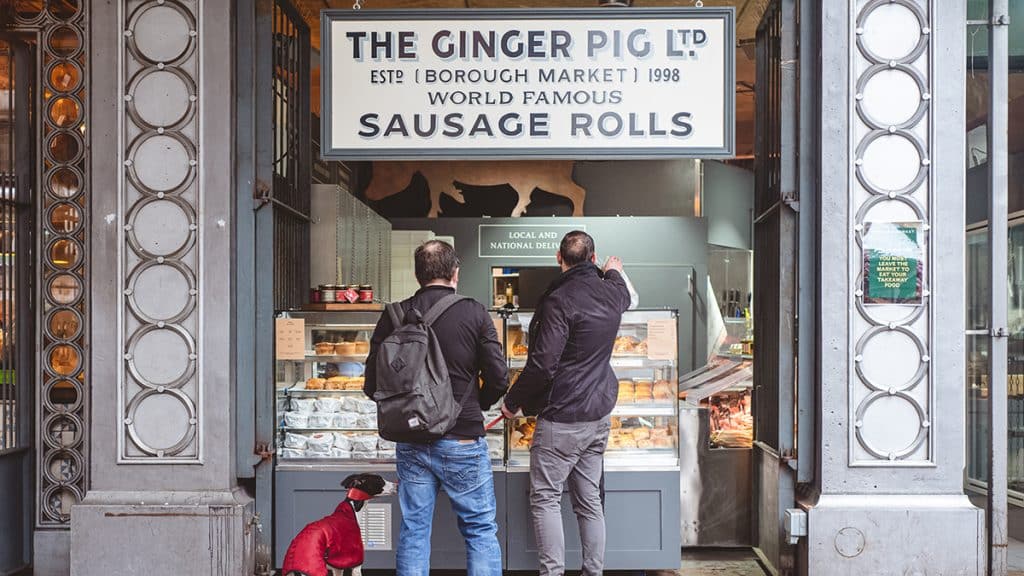
Turning fresh ingredients into cooked products is a method similarly employed by Ginger Pig. The stand’s marketing manager Nicola Swift describes their team of cooks as “our secret weapon for avoiding waste,” employed to create “all sorts of pies, sausage rolls and cooked items” from surplus meat and any flavour-packed trimmings from the butchery. Thinking of the business as an “ecosystem”, they analyse the patterns of demand from their customers and plan the creation of additional products that help manage seasonal spikes. “Everybody wants beautiful ribs of beef at Christmas, so we know we’ll have quite a lot of beef trim at that time of year,” Nicola explains. “We’ll turn that into beef sausages and beef pasties.”
Steve Hook of Hook & Son thinks of his raw milk dairy as a closed-loop system. Whenever Steve makes yoghurt and butter from the milk of his grass-fed Friesian Holstein cows, he’s left with a couple of natural byproducts: whey and buttermilk. Both items can be found on the shelves of his Borough Market stand and Steve is passionate about familiarising customers with them. “While in other parts of the world, whey is readily used, there’s not much understanding of it here,” he says, “so we’re developing a market for it. It’s a very Scandinavian thing to boil vegetables in whey instead of water. It’s great in dressings, it’s great for marinating meat.” He similarly champions buttermilk for cooking and baking. “It’s incredible how it lifts food. If you use buttermilk instead of milk in mashed potato, for example, it gets so much more flavour.” Hook & Son also makes a chocolate buttermilk ice cream, the buttermilk making it rich rather than overly sweet.
Steve isn’t the only trader using frozen desserts in the fight against food waste. “The most wonderful thing about ice cream is that it’s the perfect carrier for food waste,” explains Josie Wells, whose Greedy Goat business sells goat’s milk ice cream flavoured with “wonky fruit” that doesn’t meet supermarket standards. “Ripe strawberries, fresh peaches, all the soft fruits – anything that’s not at its best visually is always at its sweetest. There’s nothing wrong with it whatsoever,” she explains. “It’s cooked down into strawberry jam, raspberry jam and then rippled through our ice cream, and it’s amazing. That lovely sweetness means we add less sugar.”
One of the many benefits of trading at Borough Market is the potential for collaboration with other stalls, with traders finding fruitful uses for each other’s surplus produce. Josie has made a marmalade toast ice cream using unsold bread from The Flour Station, and a vanilla brownie ice cream using the trimmings from Comptoir Bakery’s huge brownie slabs. “It tastes the same, it just looks unattractive because it’s the corners.”
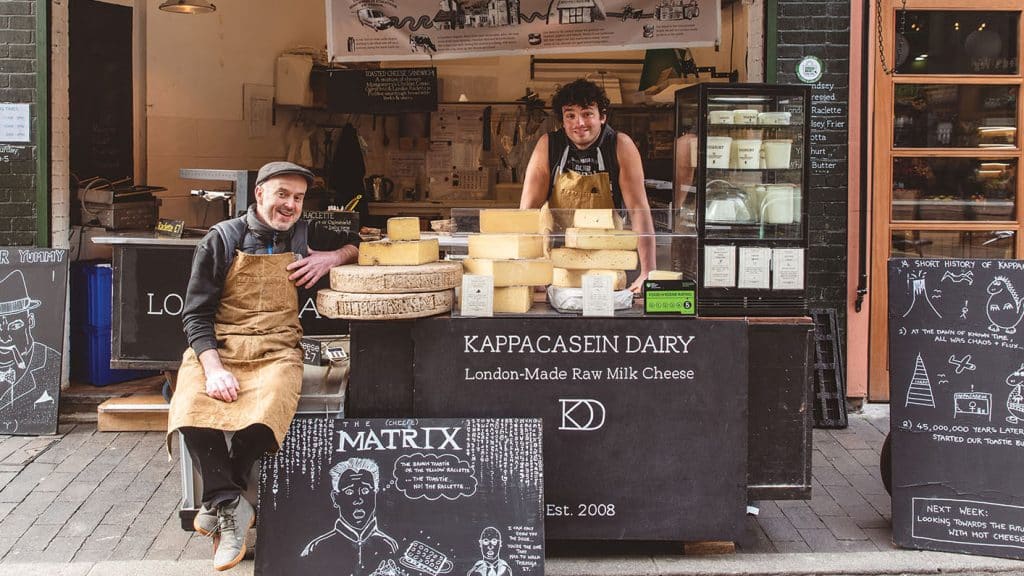
Over at Kappacasein, reducing waste was the catalyst for the creation of the business. Bill Oglethorpe first thought of making cheese toasties while working at Neal’s Yard Dairy, where cracked cheddar and day-old sourdough bread may have been past their peak but were still incredibly good. “Putting those two things together took care of a huge wastage problem and created something very desirable,” he explains.
Now, Kappacasein’s toasties are too popular to rely solely on cheese and bread that would otherwise be wasted, but Bill has applied this low-waste approach to other products sold on the stand. For example, he extends the life of his yoghurt by turning it into labneh, then uses the whey left behind from that process to make ricotta. The production of ricotta, which involves whey being heated again to form new curds, works best when the whey is fairly acidic, and Bill discovered that the labneh leftovers do the job perfectly. “It means I’m self-sufficient in my own ingredients, in a sense,” he says.
When the traders themselves can’t make use of their surplus food, Borough Market’s partnership with Plan Zheroes means it can still find a good home. At the end of the trading day, Plan Zheroes volunteers work like matchmakers, connecting the market’s leftover produce with a wide range of local charities. They use these high-quality ingredients – past their peak but still amazing to cook with – to create meals for their service users. Instead of being wasted, the traders’ wonderful food is used to feed people in the community.
Charles Foster at Turnips sums it up perfectly. “We’re selling really high-end products,” he says, “so to throw any away is criminal.”
Food for thought: fighting food waste
Chef and social media star Martyn Odell answers our question: what can shoppers do to reduce their food waste?
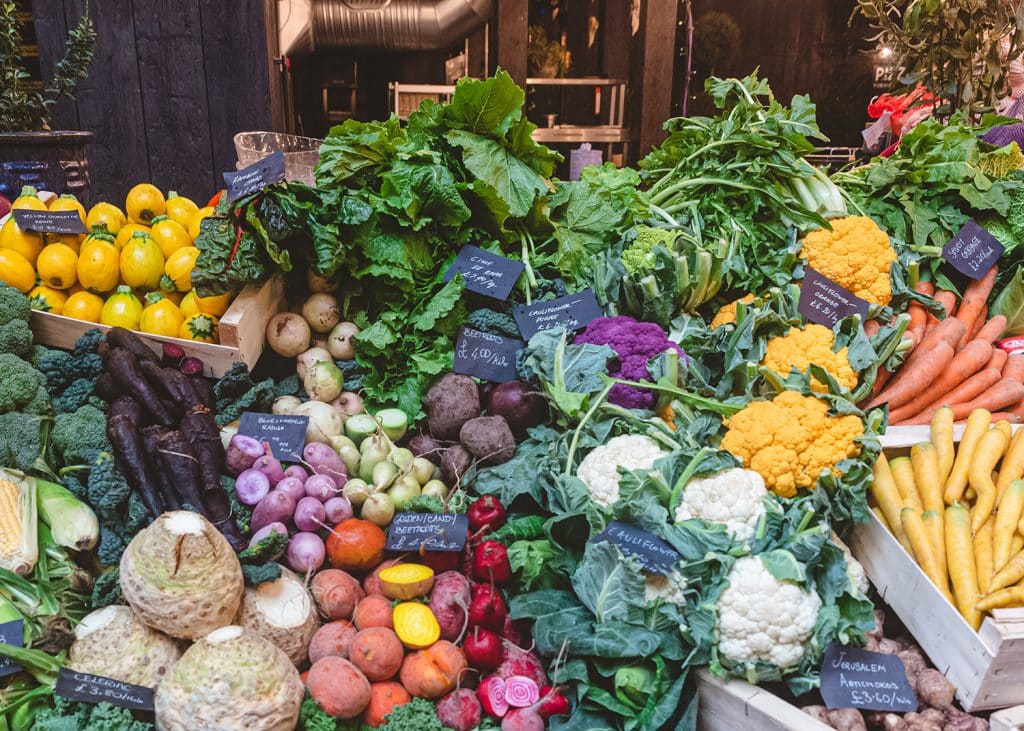

“PEOPLE EITHER CARE ABOUT THE ENVIRONMENT OR MONEY – AND SLINGING FOOD INTO A BIN DOESN’T MAKE SENSE TO ANY OF THEM”
Borough Market, which is run by a charitable trust, exists “for community, the love of food and a better tomorrow”. This statement informs everything from our Food Policy to our work with local schools; it also sparks lots of questions about what we do and why we do it. This autumn, we’re throwing some of those same questions out to experts beyond the Borough Market community.
This week’s answer comes from Martyn Odell of Lagom Chef. Martyn is a self-described “food waste disruptor” – a chef who started harnessing the power of social media to help people save money and reduce their environmental impact.
Question: What can shoppers do to reduce their food waste?
When it comes to food waste, my message is simple: “Eat the food you buy.” There really is no better solution. If you buy a banana and then eat the banana, you’ve played your part.
The beauty of this solution is that it works for everyone. There are people who care strongly about the environment, and there are people who care more about money – and the good news is that slinging something you’ve bought into a bin makes no sense to any of them.
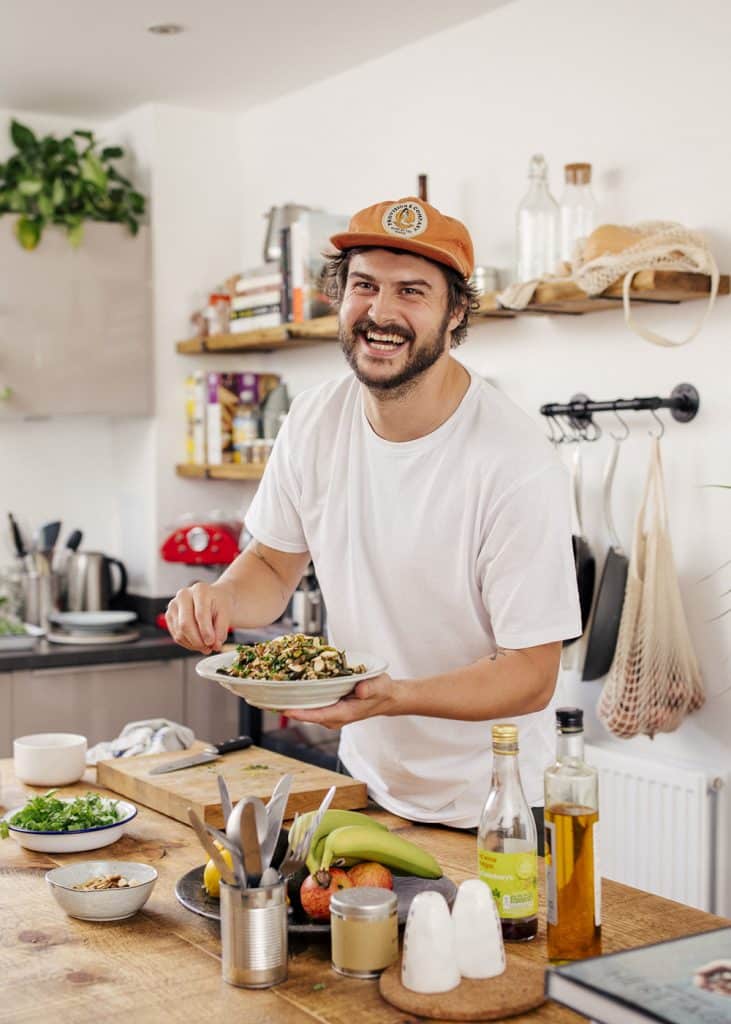
When food takes so long to produce and uses so many of our planet’s valuable resources, to throw it away seems barbaric and stupid. The production of food is a major contributor to climate change and environmental degradation, and yet so much of it is wasted. And it’s wasted by us. In the UK, 70 percent of food waste comes from people’s homes, and only 30 percent from business. When I tell people that fact, almost everyone says: “That can’t be true. Think about retail, hospitality, farming – surely that’s where the fault lies?” But no. We can’t go blaming supermarkets. We’re the problem, and it’s up to us to fix it.
At the heart of my philosophy is the idea that the dry store is the backbone of every kitchen: tins, sauces, pulses, spices, rice, pasta, all that great stuff that doesn’t really go off. Have a good dry store, then plug in fresh ingredients as and when you need them. When you’re buying produce, buy what you need, not what you think you might possibly need. You don’t have to fill the fridge: “Let’s get the chicken and the mince and a steak and loads of veg, just in case.” In London, we live in a city where most people can easily pop to the shops, pop to the market, and buy a courgette or a bit of chicken.
Meal planning helps, but while that works for some people, it’s not for everyone. I know it doesn’t work for me. I’m a freelancer with a family, and things change day by day. I’m not much of a planner, so I rely on being able to create a dish from dry store ingredients – take some spices and some beans and tinned tomatoes, throw in an onion and a courgette and I’ve got a veggie chilli. That’s the mindset I try to help people get into.
Of course, the reality is that shops often make it quite hard to buy only what you need. I’ve done a lot of work with WRAP and Love Food Hate Waste, and they’re both big on buying loose produce whenever possible. The amount of waste you can save just by doing that is insane. Markets like Borough are great – you can pick up one potato, two eggs, whatever you want. That’s perfect, ideal. But if you go to a Tesco Express, you’re getting two courgettes in a packet even if you only want one. To me the answer is obvious: don’t complain, just eat the other courgette. Either make more of whatever you’re cooking, or tomorrow you’re going to have to eat courgette again – and that’s hardly a problem. There must be 30 or 40 different ways of cooking a courgette. It doesn’t have to be a Michelin-starred meal. You could have it raw in a salad, thrown into a stir-fry or put through a sauce. Or you could blitz it down and put it in the freezer.
The freezer is one of our allies. I always say that if you’re in the kitchen making dinner, rather than being completely focused on the here and now, you should look to the future. Pickles and ferments are great, but freezing is often the easiest route. If you’re making a stir-fry and you’ve got too many peppers, why not sit there for five minutes longer, trim and slice them up and put them in the freezer for another day? If you’ve got too many potatoes, parboil them, freeze them, and you’ve got a load of half-cooked roasties ready to go. It takes time now, but it saves time later. Around 2.7 million potatoes are thrown away every day in Britain, and there’s no excuse for that.
Martyn’s tuna pitta recipe
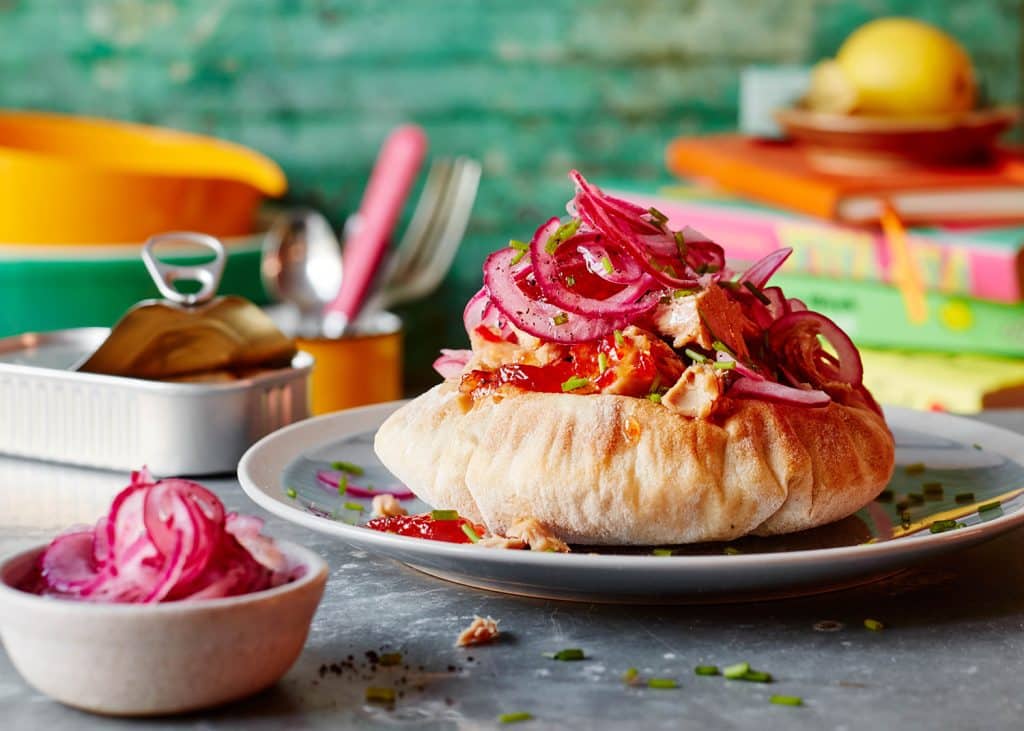
Your eyes and nose are also your friends. Forget about best-before dates; it’s only use-by dates that matter. But even then, some common sense can be applied. People are slinging out dairy products left, right and centre, and it’s often completely unnecessary. A few years ago, Too Good To Go did a campaign called Look, Smell, Taste, Don’t Waste. The idea is: look at the yoghurt, if it looks fine have a smell, then move on to tasting. It’s so easy. And don’t worry about a little fleck of green on the side of the yoghurt pot – if there’s a tiny bit of mould, that doesn’t mean the whole thing is inedible.
The important thing to remember is that any small change makes a big change. You don’t have to be perfect. A lot of what we read about cutting out food waste seems unattainable to most people. Sure, banana skin chutney is delicious, but what if your family gets through 20 bananas a week? Drying out onion skins is great – personally, I do keep some of mine for making stock –but is that something you’re realistically going to do every day in your house? Probably not, and that’s okay.
The main thing is to consume the part of the ingredient you bought it for. If you buy a banana, eat the banana. My message is: eat grub. Really, that’s all there is to it.
Food for thought: reconnecting with food
Urban farmer Chloë Dunnett answers our question: could we all benefit from being more connected to the source of our food?
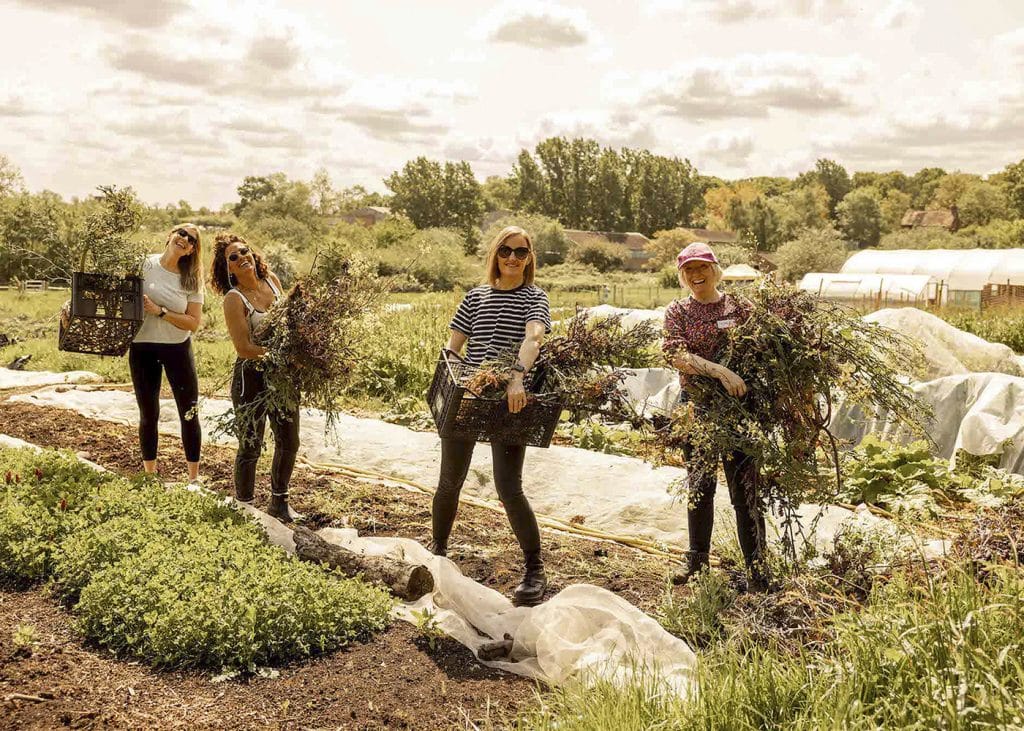

“LOTS OF MONEY IS BEING MADE, BUT IT’S NOT FARMERS MAKING IT; IT’S MASSIVE COMPANIES SELLING ULTRA-PROCESSED RUBBISH”
Images: Helena Dolby, Rachel Jones
Borough Market, which is run by a charitable trust, exists “for community, the love of food and a better tomorrow”. This statement informs everything from our Food Policy to our work with local schools; it also sparks lots of questions about what we do and why we do it. This autumn, we’re throwing some of those same questions out to experts beyond the Borough Market community.
This week’s answer comes from Chloë Dunnett, founder of Sitopia Farm, a small, not-for-profit organic farm in Greenwich. Named after a book by the author Carolyn Steel, which explores how food is both the cause of and potential solution to many of the world’s most pressing problems, Sitopia Farm seeks to reconnect its visitors and volunteers to the soil, the joy of good food, and each other.
Question: Could we all benefit from being more connected to the source of our food?
Food is at the heart of many of the crises we face as a society: the health crisis, the environmental crisis, the crisis of inequality. That means it can also be part of the solution.

Among the many failings of our food system – and it’s both a symptom and a cause – is how disconnected most people in this country have become from the food they eat. Most of what we consume is a mystery to us. We have no real clue how it was produced, who produced it, how it got to our shelves, and the impact it had along the way. Building stronger connections with food, and helping people understand how important those connections are, is a big part of our work at Sitopia Farm.
Our approach to small-scale regenerative farming, with its focus on soil health and biodiversity, is unusual but by no means unique. There are lots of organic farms out in the countryside growing amazing produce and selling directly to their local communities, just like we do. But that other part – creating connections and spreading a wider message about food and farming – is something that, because we’re in London, surrounded by millions of people, we’re almost uniquely positioned to do.
When visitors come here for the first time, on team days, courses, school visits or as volunteers, we often see them have a bit of a moment. It starts with the sensory impact – the beauty of the place, the colours and scents, the sheer diversity of the plants. Then they get to taste how delicious food can be when grown in rich soil with minimal intervention and eaten right there at the source.
Produce loses nutrients and flavour with every day that passes. The shorter the gap from harvest to table, the better it is for you and the better it tastes. For me, one of the most exciting things is converting our visitors, particularly children, to things they’re convinced they dislike. Tomatoes are a common one. Most people have only ever had the supermarket version – watery and sour. Give them a cherry tomato straight from the vine in the middle of summer and the sudden change to their expression as the intense hit of sweetness bursts in their mouth in a sight to behold. In that instant, you can’t help but appreciate how different food can be when grown this way.
Equally importantly, they get to see and experience the hard work that goes into producing that food. We want to give people the chance to get their hands in the soil, to use their muscles in the service of the plants. I defy anyone to spend a day in the hot sun or relentless drizzle, watering, planting, weeding, pruning, harvesting, and not then think a little bit more about what has gone into creating the produce they buy in the shops. I wouldn’t suggest that everyone should do what I did, leaving a secure job to become a farmer, but I do think we could all do with understanding a little better what farming involves.
This place offers a personal connection to the failures as well as the successes. Each year, some of the things you plant will do well and some won’t. When you spend time at Sitopia Farm, you quickly come to understand the vulnerability of our food supply. Farming in this country is a hard way to make a living, and it’s being made even harder by our changing climate. In the short time we’ve been here, we’ve seen such wildly varying seasons. Last year we had an unusually wet spring and quite a cool summer. This year saw the hottest summer for 70 years and the driest spring in 50. You simply can’t plan for that.
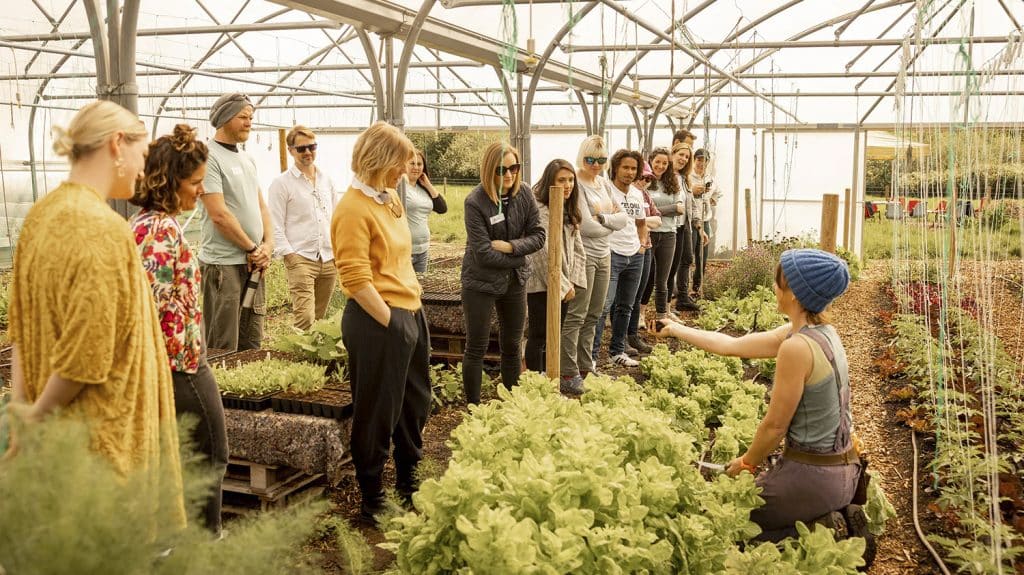
Extreme weather is just one of many challenges faced by farmers. When you zoom out, our current food system has two fundamental problems: it’s simply not profitable to make good food, and good food is priced beyond the reach of too many people. It’s a classic case of market failure – a lot of money is being made from the food we eat, but it’s not farmers who are making it; it’s massive companies selling ultra-processed rubbish. We’re succeeding in churning out cheap, abundant calories but failing to produce food that nourishes people and doesn’t kill the planet. Collectively, we pay for that cheap food in other ways. A big study by the Food, Farming & Countryside Commission in 2024 put the annual cost to the UK of diet-related disease at £268 billion – almost as much as the UK’s entire healthcare spend – and the environmental costs are equally staggering.
Those problems are systemic and need to be addressed at the very highest level through a national food policy. But as individuals, we’re not without power – that’s why the connections we make here are so important. We all vote with our forks three times a day. For those people who enjoy the luxury of choice, what we choose to buy has a direct, tangible impact. And the good news, as the experience of sampling our produce straight from the soil clearly demonstrates, is that we don’t have to make those choices purely for reasons of virtue. Many of the things we know we should do, both for our own health and the health of the planet, can seem like a chore. But eating a carrot that tastes better than any carrot you’ve eaten before is not an act of self-sacrifice, it’s a genuine pleasure.
Part of our role at Sitopia Farm is to grow those amazing carrots. Over the course of the year, what we harvest here provides about 20,000 meals through veg bag subscriptions and deliveries to restaurants and grocers. Our bigger job is to plant the idea that a better way of producing food really is possible.
